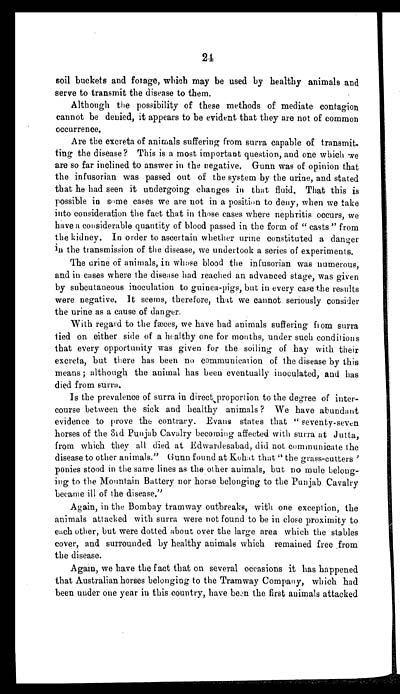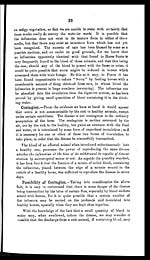Medicine - Veterinary > Civil Veterinary Departments > Civil Veterinary Department ledger series I-VI > Volume IV - Horse surra
(436) Page 24
Download files
Individual page:
Thumbnail gallery: Grid view | List view

24
soil buckets and forage, which may be used by healthy animals and
serve to transmit the disease to them.
Although the possibility of these methods of mediate contagion
cannot be denied, it appears to be evident that they are not of common
occurrence.
Are the excreta of animals suffering from surra capable of transmit-
ting the disease? This is a most important question, and one which we
are so far inclined to answer in the negative. Gunn was of opinion that
the infusorian was passed out of the system by the urine, and stated
that he had seen it undergoing changes in that fluid. That this is
possible in some cases we are not in a position to deny, when we take
into consideration the fact that in those cases where nephritis occurs, we
have a considerable quantity of blood passed in the form of "casts" from
the kidney. In order to ascertain whether urine constituted a danger
in the transmission of the disease, we undertook a series of experiments.
The urine of animals, in whose blood the infusorian was numerous,
and in cases where the disease had reached an advanced stage, was given
by subcutaneous inoculation to guinea-pigs, but in every case the results
were negative. It seems, therefore, that we cannot seriously consider
the urine as a cause of danger.
With regard to the fæces, we have had animals suffering from surra
tied on either side of a healthy one for months, under such conditions
that every opportunity was given for the soiling of hay with their
excreta, but there has been no communication of the disease by this
means; although the animal has been eventually inoculated, and has
died from surra.
Is the prevalence of surra in direct proportion to the degree of inter-
course between the sick and healthy animals? We have abundant
evidence to prove the contrary. Evans states that "seventy-seven
horses of the 3rd Punjab Cavalry becoming affected with surra at Jutta,
from which they all died at Edwardesabad, did not communicate the
disease to other animals." Gunn found at Kohat that "the grass-cutters'
ponies stood in the same lines as the other animals, but no mule belong-
ing to the Mountain Battery nor horse belonging to the Punjab Cavalry
became ill of the disease."
Again, in the Bombay tramway outbreaks, with one exception, the
animals attacked with surra were not found to be in close proximity to
each other, but were dotted about over the large area which the stables
cover, and surrounded by healthy animals which remained free from
the disease.
Again, we have the fact that on several occasions it has happened
that Australian horses belonging to the Tramway Company, which had
been under one year in this country, have been the first animals attacked
Set display mode to: Large image | Zoom image | Transcription
Images and transcriptions on this page, including medium image downloads, may be used under the Creative Commons Attribution 4.0 International Licence unless otherwise stated. ![]()
| India Papers > Medicine - Veterinary > Civil Veterinary Departments > Civil Veterinary Department ledger series I-VI > Horse surra > (436) Page 24 |
|---|
| Permanent URL | https://digital.nls.uk/75517198 |
|---|




